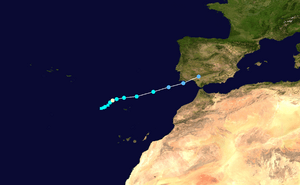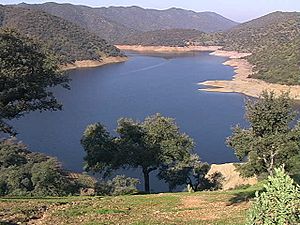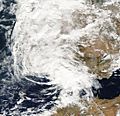Hurricane Vince facts for kids
| Category 1 hurricane (SSHWS/NWS) | |
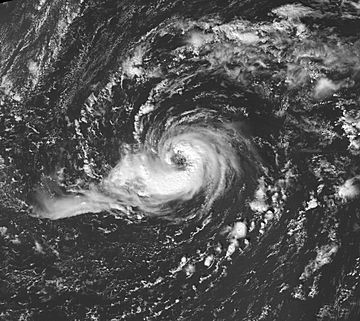
Hurricane Vince on October 9 14:13 UTC
|
|
| Formed | October 8, 2005 |
|---|---|
| Dissipated | October 11, 2005 |
| Highest winds | 1-minute sustained: 75 mph (120 km/h) |
| Lowest pressure | 988 mbar (hPa); 29.18 inHg |
| Fatalities | None reported |
| Areas affected | Madeira Islands, southern Portugal, southwestern Spain |
| Part of the 2005 Atlantic hurricane season | |
Hurricane Vince was a very unusual hurricane. It started in the northeast Atlantic Ocean. This was strange because the water there is usually too cold for hurricanes to form. Vince was the 20th named storm and 12th hurricane of the 2005 Atlantic hurricane season.
The storm that became Vince actually began as an extratropical cyclone. This is a type of storm that gets its energy from temperature differences. It then changed into a subtropical storm on October 8. This happened southeast of the Azores islands. The National Hurricane Center (NHC) didn't officially name it Vince until the next day.
Vince grew into a full hurricane. But it soon started to get weaker while still at sea. On October 11, it reached land in Spain, on the Iberian Peninsula. By then, it was just a tropical depression. It might have been the first storm like it to hit that area since 1842. Vince faded away over Spain. However, it did bring some much-needed rain to the country. What was left of the storm then moved into the Mediterranean Sea.
Contents
How Hurricane Vince Formed
On October 5, a storm called the 2005 Azores subtropical storm joined with another low-pressure area. This new system started to get more organized. It became a subtropical cyclone early on October 8. The storm was about 580 miles (930 km) southeast of Lajes in the Azores. The National Hurricane Center (NHC) didn't name it Vince right away. They thought the waters were too cold for tropical storms.
The storm slowly became more like a tropical cyclone. It developed a warm center. It became a tropical storm the next day. This happened in water cooler than 24 °C (75 °F). Tropical storms usually need water warmer than 26.5 °C (80 °F).
Vince's Journey Across the Ocean
After becoming a tropical storm, Vince developed an eye. This is a clear, calm center often seen in strong storms. The NHC then named it Tropical Storm Vince. At first, they weren't sure if it was tropical or subtropical. But later studies showed Vince became fully tropical before it was named.
The storm's eye became clearer and was about 15 mi (25 km) wide. Vince also got stronger. It reached its peak strength on October 9. At that time, its winds were 75 mph (120 km/h). This made it a very weak Category 1 hurricane on the Saffir–Simpson Hurricane Scale. One weather expert at the NHC said, "if it looks like a hurricane, it probably is." This was true even though it was in an unusual place.
Hurricane Vince quickly started to weaken. This was because of something called wind shear. Wind shear is when winds blow at different speeds or directions at different heights. This can tear a storm apart. Vince weakened back into a tropical storm. A weather system called a trough moved towards Vince. It pulled thunderstorms away from the storm's center. The storm's center then quickly moved east.
On October 10, forecasters were surprised by two short bursts of thunderstorms. But because the water was so cold, the storm kept getting weaker. Vince became even weaker as it got closer to the Iberian Peninsula. It turned into a tropical depression on October 11. This was just before it made landfall in Huelva, Spain. The fast-moving tropical depression quickly died out over land. What was left of the storm moved across southern Spain. It then went into the Mediterranean Sea south of Alicante early on October 12.
How Spain Got Ready for Vince
The Spanish Center for Emergency Coordination announced a rain warning. This was for the province of Castellón. They were worried that Hurricane Vince would bring floods. The Instituto Nacional de Meteorología (INM) also warned of a 40% chance of flooding.
Four regions in Spain (Asturias, Cataluña, Castile and León and Galicia) also issued flood warnings. The Canarias issued a wind warning. Fishing boats from Spain near the Andalusian coast went back to port. The storm hit them while they were safely docked. It did not hit them out in the open ocean.
What Happened When Vince Hit Spain
Spain had been dealing with a very bad drought that year. So, people actually welcomed the rains from Vince's leftover storm. In two days, the storm brought a lot of rain to the province of A Coruña. This helped to fill up the reservoirs. But it also caused some bad traffic and small floods.
In Cordoba province, some roads were slightly flooded. The entrance to the University of A Coruña was blocked for a short time. This was due to floodwaters on October 11. A nearby roundabout was also underwater. Overall, there was only limited damage. No one died because of the storm. The strongest winds reported on land were 48 mph (77 km/h). These winds were reported in Jerez, Spain. Some ships reported even stronger winds.
The amount of rain from the hurricane was like normal rain from other weather systems. Only one to two inches (25 to 50 mm) of rain fell. A forecaster from the National Hurricane Center joked, "the rain in Spain was mainly less than 2 inches, although 3.30 inches (84 mm) fell in the plain at Cordoba." This was a play on words from a famous song.
Vince's Special Records
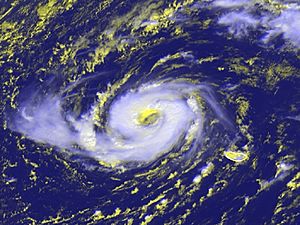
Hurricane Vince started in a very strange place. It was an area where tropical cyclones usually don't form. However, it doesn't hold any major records for where it started. Tropical Storm Alberto in 1988 formed farther north than any other storm. Also, Hurricane Ginger in 1967 formed farther east than any other tropical cyclone.
Hurricane Vince became a hurricane farther east than any known storm before 2019. It reached hurricane strength at 18.9° W. In 2019, Hurricane Pablo formed even farther east, at 18.8°W. A tropical storm becomes a hurricane when its wind speeds go higher than 74 mph (119 km/h).
The National Hurricane Center said Vince was the first tropical cyclone known to hit the Iberian Peninsula. But some old papers say that the 1842 Spain hurricane hit the Iberian Peninsula on October 29, 1842. That hurricane might have been even stronger. More recently, Tropical Storm Grace formed farther north than Vince.
Why the Name 'Vince' is Still Used
When Subtropical Storm Vince began on October 8, it was the earliest in a season that the twenty-first tropical or subtropical storm had ever formed. It was 38 days earlier than the old record. That record was set by Tropical Storm 21 in the 1933 season.
Because Vince did not cause a lot of damage, the World Meteorological Organization decided not to "retire" its name. This means the name Vince can still be used for future storms. It was on the list of names for the 2011 season.
|
Tropical cyclones of the 2005 Atlantic hurricane season |
|||||||||||||||||||||||||||||||||||||||||||||||
|
|
|
||||||||||||||||||||||||||||||||||||||||||||||
|
|
|||||||||||||||||||||||||||||||||||||||||||||||
Images for kids
-
Tropical Depression Vince over the Iberian Peninsula on 11 October
See also
 In Spanish: Huracán Vince para niños
In Spanish: Huracán Vince para niños


